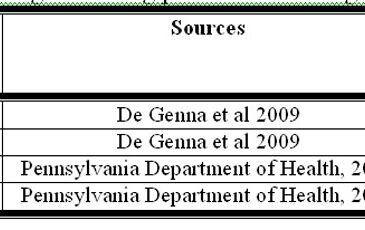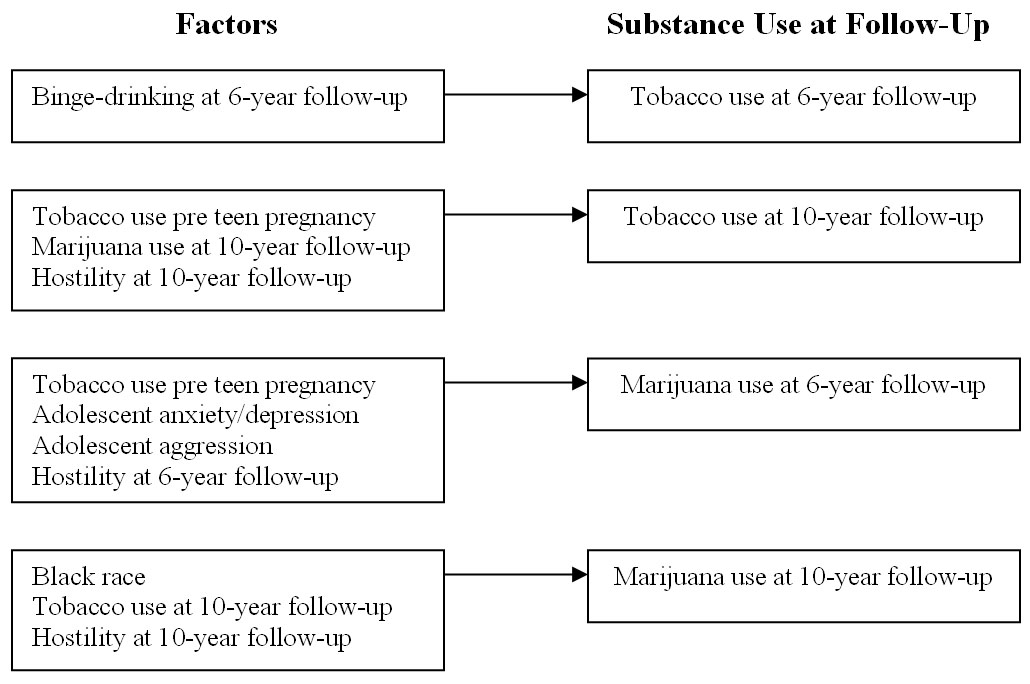According to the recent Center for Disease Control’s National Vital Statistics Reports, after years of decline, the rates of teenage pregnancy in the U.S. are rising to 41.9 births per 1000 females (Center for Disease Control and Prevention, 2009). This week the STASH reviews research by De Genna, Cornelius, and Donovan (2009) who conducted a 10-year follow-up examining the risk factors for substance use among women who were teenage mothers.
Method
- Pregnant teenagers (n=445, mean age 16.32 ± 1.89, range 12-18 years) were recruited from a Pittsburgh, PA prenatal clinic and interviewed about past year substance use related experiences at three different time points:
- (1) during pregnancy at recruiting;
- (2) 6 years after recruitment;
- (3) 10 years after recruitment.
- 292 participants provided complete data (68% follow-up rate)
- Data collection:
- Demographic information: race, education, family income.
- Substance use information (cigarette, alcohol, marijuana, cocaine, and other drug): age at initiation of substance use, peer substance use, frequency, and quantity of substance use.
- Physical and mental health information: depression, aggression, and hostility.
Results
- Researchers did not observe any difference between the original recruited cohort and the follow-up cohort with respect to demographic information, substance use information, and physical and mental health information.
- As Table 1 shows, teenage mothers in this study cohort remained at higher risk for substance use compared to other young women or adults in the state of Pennsylvania (Pennsylvania Department of Health, 2004)
Figure. Tobacco use and binge-drinking prevalence among different populations. Click image to enlarge.
- Investigators used logistic regression models to identify factors that influence tobacco use, binge-drinking, and marijuana use, among teenage mothers at follow-up (all p < 0.05).
Figure. Factors associated with tobacco and marijuana use at both 6-year and 10-year follow-up. Click image to enlarge.
- As Figure 1 shows, for tobacco use at 6-year follow-up, women who engaged in binge-drinking at 6-year follow-up were more likely to smoke.
- Tobacco use before pregnancy was a significant predictor of tobacco use at 10-year follow-up, while concurrent marijuana use and higher levels of hostility were associated with higher tobacco use at 10-year follow-up.
- For marijuana use at 6-year follow-up, tobacco use pre teen pregnancy and higher levels of adolescent anxiety/depression are significantly predictors of marijuana use, and higher levels of hostility at follow-up were associated with higher marijuana use.
- Race is a significant predictor for marijuana use at 10-year follow-up, indicating that Black mothers were more likely to use marijuana than white mothers; further, use of tobacco and hostility were associated with marijuana use during the 10-year follow-up.
Limitations
- We might not be able to generalize the results of this investigation to teenage mothers from other parts of the country, or to those from other socioeconomic or different racial/ethnic backgrounds.
- This study relied on self-report of substance use, with no biochemical verification.
- This study lacks comparison groups. For example, un-pregnant female teenagers who use substances and were matched for age, socioeconomic, and other demographic features.
Conclusions
- The investigators found that higher levels of hostility were associated with both tobacco and marijuana use at follow-up; this indicates that psychological issues might be associated with substance use.
- The investigators also identified that other substance use was associated with tobacco use, binge-drinking, and marijuana use among teenager mothers.
—Evelyn Chao
What do you think? Please use the comment link below to provide feedback on this article.
References
Center for Disease Control and Prevention. (2009). Births: Final Data for 2006. National Vital Statistics Reports, 57(7).
De Genna, N. M., Cornelius, M. D., & Donovan, J. E. (2009). Risk factors for young adult substance use among women who were teenage mothers. Addictive Behaviors, 34(5), 463-470.
Pennsylvania Department of Health. (2004). Behavioral Health Risks of Pennsylvania Adults. http://www.dsf.health.state.pa.us/health/cwp/view.asp?a=175&Q=243554







Marcos Braaten December 12, 2011
Marcos Braaten
Great blog post.Really thank you! Will read on…